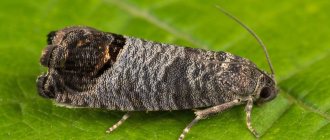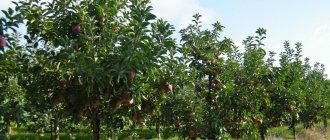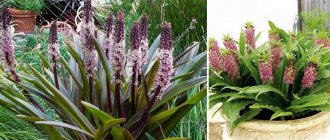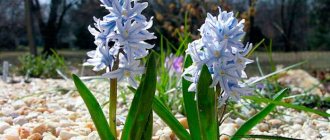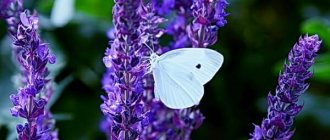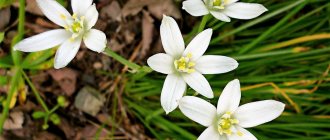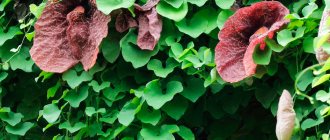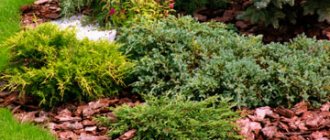Gardening » Apple tree
0
600
Article rating
Kira Stoletova
The apple moth (or apple moth) is a small insect from the ermine family of lepidoptera. This is a dangerous pest of apple trees. Distributed in European countries, including the Siberian part of Russia.
Ways to combat apple moth
Fighting methods
It is imperative to take measures to combat apple tree leaf miner, even with a slight infestation of trees.
Otherwise, the pest caterpillars, feeding on the leaf parenchyma and having the ability to move from one tree to another, will cause the death of apple inflorescences and lack of harvest.
For minor damage to trees, the use of mechanical methods is sufficient. If there are a large number of caterpillars and pupae of leafminer moths, the use of insecticidal agents of natural or chemical origin is required.
Biological products and insecticides
If there are a significant number of cobweb nests, moths on an apple tree can only be destroyed by spraying the trees with insecticides.
Specialized stores offer a wide variety of drugs that have properties that are harmful to parasites.
The main ones:
- Biological agents, harmless to people and animals. Lepidocide - this drug should be diluted at the rate of 20 g per ten liters of water. Bitoxibacillin - the given product is recommended to be diluted according to the following proportions: sixty grams per ten liters.
- Paraffin-based products. Entobacterin, Dimilin. It is also recommended to use preparations based on paraffin. The above means allow you to destroy caterpillars and egg laying.
- Chemical insecticides. Inta Vir, Actellik, Fozalon. These drugs contain chemicals that have a detrimental effect on caterpillars.
It is necessary to use any drugs taking into account the fact that codling moth worms quickly develop immunity to the action of a certain drug.
Accordingly, if constant treatment is necessary, insecticidal preparations must be changed regularly. It is especially important to do this during the period when the caterpillars begin to pupate.
Feeding parallel to drug treatments
Apple moth, with a large number of these parasites, often causes the death of fruit trees.
The use of insecticidal preparations can also have a negative impact on the condition of apple trees. To avoid this, it is important to use mineral and vitamin supplements, the composition of which is designed specifically for fruit trees.
It is recommended to apply prepared fertilizers immediately after treating trees with insecticidal agents against apple moths.
Natural enemies
Natural enemies of the caterpillars will help fight apple moths. Unfortunately, the diet of most birds does not include apple moths, but there is another way to deal with parasites.
There is a special type of insect called the ichneumon ichneumon, ageniaspis. These flying insects are also classified as parasitic.
The specificity of the life cycle of the ichneumon fly is as follows: during the breeding period, insects lay eggs in clutches of apple moths. Hatched Ageniaspis larvae feed on pest tissue until hatching.
To destroy caterpillars and prevent their appearance, it is recommended to purposefully breed ageniaspis in the garden.
Video
Effective ways to combat apple moth on an apple tree. Issue 226
Description of the pest
The apple or apple moth is a small butterfly belonging to the family of ermine moths.
It is also called the notched winged butterfly, the leaf roller, and the leaf spinner. Most often it is painted white-silver, has a small size and a wingspan of up to 22 mm, along which black dots are located longitudinally. The body of the insect is covered with a velvety coating; on the head there are long, thread-like antennae, bent back in a calm state. Every gardener needs to know in person what kind of pest this is - the apple moth; a photo of this parasite can be seen below.
This pest is capable of infecting a tree so severely with its activity that it simply stops developing normally - it sheds the ovary and stops forming buds of future fruits and leaves.
The distribution and picking area of the apple ermine moth is very wide; it can be found in the USA and Canada, throughout Europe, as far as Finland and Sweden; its activity has also been observed in Pakistan, Korea and Japan.
The apple moth, like other representatives of this species, is a nocturnal insect that develops its activity in the evening and at night. The appearance of insects occurs in June. With the arrival of twilight, pest butterflies begin their active years and no less active mating, since their main task during this period is prolongation of the genus. During the day, the moth sits quietly on the back of leaves or in the grass.
The apple tree pest begins its vigorous activity immediately after the appearance of the first green leaves, which are the main area of damage.
First, the apple moth caterpillars, emerging from hibernation, eat the inner parts of the leaves, leaving their skin intact. After the apple trees bloom, the caterpillars begin to molt, feed on the leaves and build webs in the “meal area.”
This “feast” of moth larvae lasts about a month, after which, having had their fill of leaves, the caterpillars begin the process of natural pupation. It lasts about 14 days and eventually, after the trees bloom (a month later), butterflies appear.
They lay eggs in the bark of a tree and cover them with a layer of mucus. Each female can lay 60-70 eggs. In a month, small caterpillars will see the light. They will remain in this state for the winter. In one year, only one generation of this apple pest changes.
Traditional methods
How to fight apple moth, what methods are best to use, depends on the degree of infestation of trees and the number of pests.
Traditional methods of exterminating apple moths:
- Mechanical destruction. If the number of parasites is small, it is permissible to tear off infected leaves or spider nests. If one or more nests are identified, you need to periodically inspect the apple trees for the appearance of parasites on them. By carrying out regular preventive inspections, it is quite possible to prevent the spread of pests.
- Sticky traps. To destroy butterflies and caterpillars of apple moths, belts with a sticky composition can be placed on the trunks of apple trees. Once on them, pests will not be able to escape. This measure is also effective when insect numbers are low.
- Infusion of hot pepper. To prepare it, pour a few handfuls of peppers into a liter of boiling water and simmer over low heat for an hour. Add a handful of pre-grated laundry soap to the resulting solution. Spray the trees with the prepared product.
- Shag. Leave a handful of the product to steep for several days, after pouring a liter of boiling water over it. Treat infected plants with the prepared solution. This product is completely safe for plants; you can even spray it on apple tree inflorescences.
- Lime. A solution of slaked lime will help to somewhat reduce the risk of infection, using which you should treat the lower part of the tree trunk, that is, whiten it.
The use of folk remedies is justified only for a small number of apple parasites.
If the plant is literally entangled in caterpillars of pests, the use of insecticidal agents is required, which have a detrimental effect on the larvae and adults of the apple moth.
How to fight pocket leaf miner on apple trees
In the photo, the pocket moth is a miner. In the photo, the caterpillar of the pocket moth
Pocket miner moth, or white-spotted pocket moth
Ornix petiolella Frey (syn. Parornix petiolella FreyJ
, is a small gray butterfly with a wingspan of up to 12 mm. The front wings are very narrow, gray, with numerous oblique light strokes, the hind wings are light gray, with a long delicate fringe. The caterpillars are very small, yellow-green, with 7 pairs of legs, live in white rounded mines under the upper skin of the leaf, eating away the parenchyma. The length of the mines is 10 mm, and the width is 5 mm. Damages apple leaves, less often the leaves of pears and stone fruits .
How to fight moths on apple trees is described further on the page - use all available means and methods.
Control measures
In the photo, the hawthorn circle moth. In the photo, the caterpillars of the hawthorn moth.
Hawthorn moth
Cemiostoma scitella
L. - a small butterfly with narrow wings and long delicate fringe. They become entangled in the leaf parenchyma, forming mines. Mines in the form of small round wide spots of a dark color, usually several on a leaf, excrement arranged in a spiral visible through the skin. In addition to apple trees, moths are often found on hawthorn, cherry, and rowan.
Control measures.
The same as against the pocket moth.
In the photo, apple moth. In the photo, caterpillars of the apple moth.
Apple moth
Lithocolletis pomiella Grsm
. - a small butterfly with a wingspan of 8-9 mm. The wings are long, narrow, fringed with delicate fringe. The black caterpillar lives under the epidermis of the upper side of the leaf and feeds on the parenchyma, forming a mine. The mine is spot-shaped, excrement is usually collected in the corner part of the mine.
Control measures.
The same as against the pocket moth.
In the photo, the baby apple moth. In the photo, the caterpillar of the baby moth.
The little apple moth, or little apple leaf miner
Stigmella malelli Stt
., is a very small butterfly with a wingspan of up to 5 mm. The wings are thin, narrow, lanceolate, with a fringe of long shiny hairs. The head is covered with dense hairs, the first antennal segment is expanded, the venation of the wings is reduced. The caterpillar is yellowish-white, flat, legless, and feeds on the parenchyma inside the leaf, making long, thin, flagellate-like, often thread-like mines on the upper side of the leaves. It is widespread and causes the greatest harm to apple trees.
Control measures.
The same as against the pocket moth.
In the photo there is a white apple moth. In the photo there is a caterpillar of the apple moth.
The white apple moth, or apple miner
Lyonetia clerckella L.
, is a small butterfly with narrow fore wings of a silver-gray or brownish color.
There is a black protrusion at the apex, and 3 black spots on the leading edge. Hind wings with fringe. The caterpillars are light green, with a dark head and dark legs, body length 5 mm. The second generation butterflies overwinter and partly the eggs they lay at the base of the buds. In the spring, caterpillars emerging from eggs bite into young leaves and feed there. Overwintered butterflies lay eggs on leaves. The emerging caterpillars live inside the leaf blade and make narrow winding passages, filling them with their excrement.
Feeding lasts 20-25 days, the caterpillars gnaw a hole on the underside of the leaf and pupate near it in a white cocoon. After about two weeks, the butterflies emerge and begin laying eggs on the leaves. In September-October, butterflies of the second generation appear and overwinter. The baby moth severely damages apple trees, stone fruits, mountain ash, hawthorn, shadberry, and many deciduous trees in orchards.
Control measures.
The same as against the pocket moth.
It’s May, everything around is blooming and fragrant, the garden is pleasing to the eye... And suddenly you notice a web on the bird cherry bushes... No, these are not those silky threads that harmless spiders pull. White dense cocoons are what will alarm you. Things can go so far that the entire bush will be shrouded in a cobweb. What happens to the bird cherry? What kind of trouble can you expect from this web?
Why is it dangerous?
Apple moth or leaf roller is especially dangerous for orchards when there is a large number of parasites. Eating by caterpillars, as well as the webbing of a large number of green leaves, causes disruption of photosynthesis processes.
This leads to a decrease in the tree’s resistance to the negative effects of external negative factors, such as cold.
After an invasion of apple pests, if their number was significant, infected apple trees may not bear fruit for two or more years. Restoring the tree's abilities may require a significant amount of time and effort.
After eliminating the parasites, it is necessary to apply fertilizing and fertilizers that will help the apple tree regain its strength.
Brief description of apple moth
These snow-white butterflies with black markings on their narrow wings are nocturnal. Because of their unusual (“royal”) coloration, they were called ermine moths. There are no patterns on the hind (silver-gray) wings. The brown head of the butterfly is covered with a mass of hair-like scales pressed to the forehead. On the crown they form a crest. The antennae of insects are half as long as the body.
Despite their small size (wingspan no more than 13 mm), apple moths are capable of destroying the entire fruit crop if their reproduction occurs unhindered. In addition to high fertility, insects are omnivorous and cause great damage to the health of trees.
Pests spoil the bark, eat leaves, and prevent buds and growing fruits from developing.
Apple moths are sexually dimorphic. Females are larger than males and have a lighter color. During the mating season, males attract females with the help of a specific smell (secret).
Reasons for appearance
The appearance of apple moth caterpillars is the result of clutching by adult butterflies. This happens during the end of the summer period.
Young pests emerge from clutches in the fall, after which the larvae remain for the winter, feeding on the bark of the infected tree until the onset of cold weather.
During winter, apple parasites fall into an anabiotic state; a supply of nutrients allows them to survive during this harsh period. In the spring, the parasites begin to actively consume greenery and grow, reaching the pupation stage in two months.
What harms the butterfly or the caterpillar?
Of course, the butterfly indirectly harms the apple moth by laying eggs, but it is the caterpillar that causes significant harm, which, in addition to apple trees, takes pleasure in literally destroying the harvest of chaenomeles (Japanese quince) and pears. The caterpillar is yellow in color and has a couple of rows of pitch-black dots. Its body reaches a length of only one and a half centimeters, and it is protected from the return of cold weather by a completely reliable shield.
[YaDir01]
As soon as it gets warmer and the return of cold weather is no longer scary for the apple moth caterpillar, it deftly frees itself from this shield and begins to “mine” the leaf blades. It actively absorbs the leaf mass, forming a kind of nest, or a braid of cobwebs, around its location.
In this nest, as if at home, the caterpillar of the apple moth feeds on the green mass, and as soon as it runs out, it moves further and so, leaf by leaf, hordes of caterpillars can destroy all the green mass on these plants.
The most interesting thing is that one apple moth caterpillar feeds almost without interruption for forty days in a row. Even one caterpillar will leave a two- to three-year-old apple tree seedling without leaves during this time, and a hundred caterpillars will leave a completely mature tree.
Well-fed caterpillars pupate in their nests, then turn into apple moth butterflies, and just 10-12 days after transforming into a butterfly, they will be ready to make a new ovipositor, sometimes consisting of a record number of eggs - up to seven dozen.
To protect them from birds, they are covered with an adhesive mass; this is a special composition secreted exclusively by apple tree moths. In the future, if the caterpillars hatch and there is nothing for them to eat, they will hide under this sticky mass and wait there all winter. Usually the butterfly lays eggs on the bark of the thinnest tree branches.
Pear moth
Damages only pear fruits. The butterfly is similar in appearance to the codling moth, but unlike it, the oval spot on the top of the forewing has a silvery rather than bronze tint.
Develops in one generation. Caterpillars overwinter in a cocoon in the top layer of soil and under plant debris. In the spring they pupate, and 30-35 days after autumn pear varieties bloom, butterflies emerge. They fly for about a month. Butterflies are active from sunset to nightfall. Females lay eggs one at a time on pear fruits. The hatched caterpillars gnaw through the lower shell of the egg and immediately beneath it penetrate into the fruit. In the pulp of the fruit they make their way to the seed chamber. A small depression forms on the surface of the fruit at the site where the caterpillar enters. The caterpillar feeds on the seeds of the fruit. All its development takes place in one fruit. The fed caterpillars make a direct move outwards, unlike the codling moth, without polluting it with excrement. Around the exit hole of the caterpillar, the fruit pulp rots, a brown spot with concentric circles of fruit rot spores is formed. A massive emergence of caterpillars from fruits and their departure to wintering areas is observed in late July - the first half of August. Early varieties of pear are more damaged by the codling moth.
Control measures. Loosening the soil in tree trunk circles in the summer, digging up the soil in the fall, raking and burning fallen leaves and plant debris are quite effective. It is recommended to spray trees with fury, sumi-alpha or karbofos. Repeat spraying after 12 days. Since caterpillars do not crawl on the surface of the fruit after hatching from the egg, the first spraying is carried out at the beginning of the butterflies’ flight so that mass egg laying takes place on fruits already covered with pesticides. The onset of butterfly flight can be determined using pheromone traps or by the sum of effective temperatures of 400 degrees. Instead of insecticides, spraying can be done with lepidocide at a concentration of 20-25 g per 10 liters of water.
